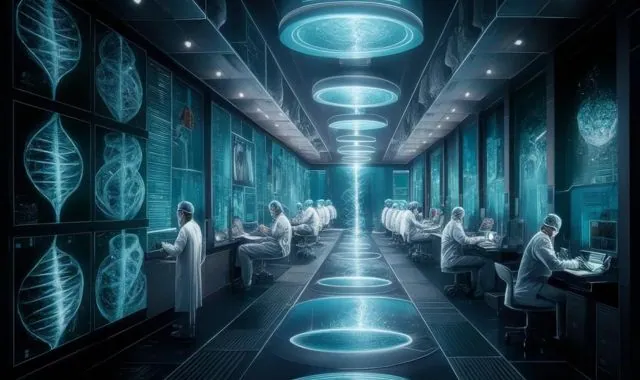Physical Address
304 North Cardinal St.
Dorchester Center, MA 02124
Physical Address
304 North Cardinal St.
Dorchester Center, MA 02124

Genetic technology unlocks the code of life, allowing us to manipulate DNA for advancements in medicine, agriculture, and more. Gene editing, gene therapy, and GMOs are some of its tools, but ethical considerations regarding safety and human germline editing require careful navigation. This powerful technology has the potential to create a healthier and more sustainable world.

Have you ever wondered what makes you, you? The answer lies within the intricate dance of genes and DNA, the very code of life. Genetic technology, a rapidly evolving field, allows us to manipulate and understand this code, ushering in a new era of possibility. Let’s delve deeper and explore the exciting world of genetic technology.
Our genetic blueprint is stored in DNA (deoxyribonucleic acid), a molecule that resembles a twisted ladder. Each rung of this ladder is made up of smaller units called nucleotides. The specific sequence of these nucleotides forms genes, which act as instructions for building proteins, the building blocks of life. Understanding this fundamental structure is key to unlocking the power of genetic technology.
Genetic technology empowers us to manipulate and modify DNA. This can involve adding, removing, or altering specific genes to achieve desired outcomes. It’s like editing the code of life itself, opening doors to revolutionary advancements in medicine, agriculture, and beyond.
Just like any skilled craft requires the right tools, genetic technology utilizes a sophisticated toolbox of techniques. Here’s a glimpse into some of the most important ones:
Restriction enzymes act like molecular scissors, precisely cutting DNA at specific locations. Ligation, on the other hand, functions as molecular glue, seamlessly joining pieces of DNA to create new combinations. These techniques form the foundation for many genetic manipulations.
Imagine replicating a single strand of DNA into millions! PCR, or Polymerase Chain Reaction, does just that. It’s a powerful tool for amplifying specific DNA fragments, crucial for various applications like genetic testing and forensic science.
Think of a vector as a tiny delivery truck. In genetic modification, vectors, often modified viruses or plasmids, carry the desired DNA into a host cell. Transformation is the process of introducing this foreign DNA into the host cell, allowing its integration and expression.

Genetic technology is revolutionizing various fields. Here are some of the most impactful applications:
Gene therapy offers the potential to treat genetic diseases by introducing functional copies of genes to replace defective ones. This holds immense promise for diseases like cystic fibrosis and sickle cell anemia.
Genetic testing allows us to identify individuals with an increased risk of developing specific diseases. This early detection empowers preventive measures and personalized treatment plans.
Biofortification utilizes genetic modification to enrich crops with essential vitamins and minerals. This can help combat malnutrition and improve the health of millions.
The immense power of genetic technology comes with ethical considerations:
Germline editing modifies genes that can be passed on to future generations. The potential unintended consequences raise ethical concerns about altering the human gene pool in this way.
The potential impact of genetically modified organisms (GMOs) on the environment is a subject of ongoing debate. Rigorous research and regulations are crucial to ensure the safe use of GMOs.
The field of genetic technology is constantly evolving. Here are some exciting possibilities on the horizon:
Imagine a future where medical treatments are customized based on your unique genetic makeup, maximizing effectiveness and minimizing side effects.
CRISPR, a revolutionary gene-editing tool, offers unparalleled precision and holds immense potential for correcting genetic disorders and developing novel therapies.

Genetic technology presents a powerful tool for shaping the future of medicine, agriculture, and even ourselves. By understanding its applications and navigating the ethical considerations, we can unlock its true potential to create a healthier, more sustainable world.
A: Genetically modified crops offer several potential benefits, including:
GMO crops can be engineered to resist pests, diseases, and harsh environmental conditions, leading to higher yields.
Biofortification allows crops to be enriched with essential vitamins and minerals, addressing malnutrition in vulnerable populations.
Pest-resistant GMO crops can significantly decrease the need for insecticides, benefiting both human health and the environment.
A: Extensive research has shown that currently available GMO crops are safe for human consumption. Regulatory bodies around the world rigorously assess the safety of GMOs before they are approved for commercial use.
A: Human germline editing, which modifies genes that can be passed on to future generations, raises significant ethical concerns. Many countries have regulations or bans on this practice due to the potential for unintended consequences.
A: If you’re considering genetic testing, it’s important to consult with a healthcare professional or genetic counselor. They can explain the risks and benefits of different tests and help you decide if it’s right for you.
A: The future of genetic technology is incredibly exciting. Advancements in gene editing tools like CRISPR, personalized medicine, and gene therapy hold immense promise for treating diseases, improving human health, and ensuring a more sustainable future.